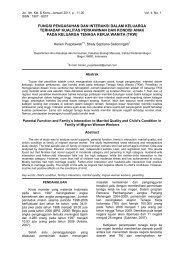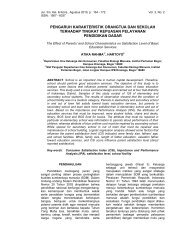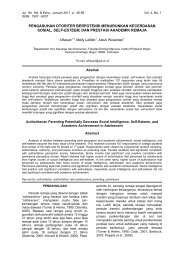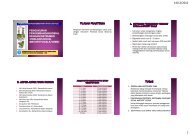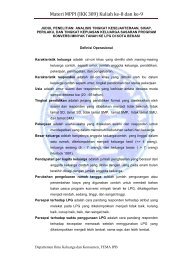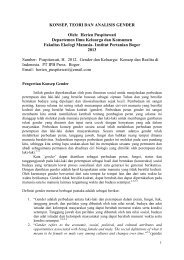The Future of Social Marketing
The Future of Social Marketing
The Future of Social Marketing
- No tags were found...
Create successful ePaper yourself
Turn your PDF publications into a flip-book with our unique Google optimized e-Paper software.
KnowledgeSolutionsJanuary 2010 | 73<strong>The</strong> <strong>Future</strong> <strong>of</strong> <strong>Social</strong><strong>Marketing</strong>By Olivier Serrat<strong>Social</strong> marketing isthe use <strong>of</strong> marketingprinciples andtechniques to effectbehavioral change. Itis a concept, process,and application forunderstanding whopeople are, whatthey desire, andthen organizingthe creation,communication, anddelivery <strong>of</strong> productsand services to meettheir desires as well asthe needs <strong>of</strong> society,and solve serioussocial problems.Introduction<strong>Marketing</strong> is at a crossroads. Until 1960, when <strong>The</strong>odoreLevitt wrote <strong>Marketing</strong> Myopia, 1 it had not been considereda serious function <strong>of</strong> strategic management. From there,the discipline developed at such pace that <strong>Marketing</strong>Management, 2 Philip Kotler’s classic textbook, is in its 13thedition counting 816 pages.Organizations have never had such powerful informationand communication technologies 3 with which to interactwith clients, audiences, and partners; explore, find, capture,store, analyze, present, use, and exchange information dataand information about them; and tailor products and services accordingly. Along withthat, never before have end users expected to interface so closely with organizations andwith one another to define and shape what they need. In its highest form, marketing isnow considered a social process, composed <strong>of</strong> human behavior 4 patterns concerned withexchange <strong>of</strong> resources or values. 5 It is no longer a mere function used to increase businesspr<strong>of</strong>its.Tellingly, in the 2010s, the attention <strong>of</strong> public sector agencies, nongovernmentorganizations, and the private sector is increasingly drawn to the potential <strong>of</strong> socialmarketing. In an age <strong>of</strong> climate change, environmental destruction, natural resourceshortages, fast population growth, hunger and poverty, as well as insufficient social1<strong>The</strong>odore Levitt. 1960. <strong>Marketing</strong> Myopia. Harvard Business Review. July–August.2Philip Kotler and Kevin Keller. 2008. <strong>Marketing</strong> Management. Prentice Hall. <strong>The</strong> topics covered brand equity,customer value analysis, database marketing, e-commerce, value networks, hybrid channels, supply chainmanagement, segmentation, targeting, positioning, and integrated marketing communications.3<strong>The</strong>y encompass radio, television, cellular phones, computer and network hardware and s<strong>of</strong>tware, satellite systemsand so on, as well as the various services and applications associated with them, such as videoconferencing anddistance learning.4Human behavior is the population <strong>of</strong> behaviors exhibited by human beings under specific conditions andinfluenced by culture, values, ethics, rapport, authority, persuasion, coercion, attitudes, emotions, hypnosis,and/or genetics.5<strong>The</strong> motivation to become involved in an exchange is to satisfy needs.
KnowledgeSolutionsservices, what contributions might marketing make? Expressly, some ask whether the tools <strong>of</strong> marketing canbe used to promote public goods in areas other than public health, the traditional arena <strong>of</strong> social marketing. 6Might, for instance, its applications help encourage wider socially and environmentally beneficial behavioralchanges, promote protective behaviors, prevent risky behavior, increase use <strong>of</strong> community services, or facilitatethe formulation and adoption <strong>of</strong> new policies and standards? <strong>The</strong> behavior, that is, not just <strong>of</strong> individual citizensbut also <strong>of</strong> public sector agencies, nongovernment organizations, and the private sector.Definition<strong>The</strong> term “social marketing” was coined by Philip Kotler and Gerald Zaltman 7 in 1971. Drawing from bodies<strong>of</strong> knowledge such as psychology, sociology, anthropology, political science, and communication theory—with practical roots in advertising, public relations, and market research—it is the application <strong>of</strong> principlesand techniques drawn from the commercial sector to influence a target audience to voluntarily accept, reject,modify, or abandon a behavior for the benefit 8 <strong>of</strong> individuals, groups, organizations, or society as a whole. Itsintent is to create positive social change. It can be applied to promote merit products and services or to make atarget audience avoid demerit products and services and thus promote its well-being.<strong>The</strong> Dimensions <strong>of</strong> <strong>Social</strong> <strong>Marketing</strong>Some consider social marketing to do little but use the principles and practices <strong>of</strong> generic marketing to achievenoncommercial goals. This is an oversimplification: social marketing involves changing seemingly intractablebehaviors in composite environmental, economic, social, political, and technological circumstances with (more<strong>of</strong>ten than not) quite limited resources. If the basic objective <strong>of</strong> corporate marketers is to satisfy shareholders,the bottom line for social marketers is to meet society’s desire to improve quality <strong>of</strong> life. 9 This requires along-term planning approach that moves beyond the individual end user to groups, organizations, and society,characterized in the figure below. Hence, the desired outcomes <strong>of</strong> social marketing are usually ambitious: theproducts are more complex, demand is diverse, the target groups are challenging, the necessary involvement<strong>of</strong> end users is greater, and competition is more varied. However, like generic marketing, behaviors are alwaysthe focus: social marketing is also based on the voluntary (but more difficult) 10 exchange <strong>of</strong> costs and benefitsbetween two or more parties. To this end, social marketing too proposes a useful framework for planning, aframework that social marketers can associate with other approaches at a time when global, regional, national,and local problems have become more critical. (<strong>The</strong> other approaches might include advocacy; mobilizingcommunities; building strategic alliances with public sector agencies, nongovernment organizations, and theprivate sector; 11 and influencing the media.) Unsurprisingly, besides public health, 12 social marketing is beingapplied in environmental, 13 economic, 14 and educational 15 fields, among others.6Famously, as long ago as 1952, research psychologist Gerhart Wiebe posed the much-quoted question, “Why can’t you sell brotherhoodand rational thinking like you sell soap?” He then argued that the success <strong>of</strong> mass persuasion, in terms <strong>of</strong> motivating behavior, is a function<strong>of</strong> the audience member’s experience with regard to five factors: (i) the force, (ii) the direction, (iii) the mechanism, (iv) the adequacy andcompatibility, and (v) the distance. See Gerhart Wiebe. 1952. Merchandising Commodities and Citizenship on Television. <strong>The</strong> Public OpinionQuarterly. Vol. 15, No. 4, pp. 679–691.7Philip Kotler and Gerald Zaltman. 1971. <strong>Social</strong> <strong>Marketing</strong>: An Approach to Planned <strong>Social</strong> Change. Journal <strong>of</strong> <strong>Marketing</strong>. Vol. 35, pp. 3–12.8Behavior will change only if perceived benefits outweigh perceived costs.9This does not mean that commercial marketers cannot contribute to achievement <strong>of</strong> social good.10<strong>Social</strong> marketing asks target audiences to do something for which social marketers will not always be able to give immediate payback, orshow them something in return, most importantly in the near term. In addition, they must usually concentrate on removing barriers to anactivity while enhancing the benefits.11Many social marketing issues are so complex that one organization cannot address them alone.12Applications include cholesterol, tobacco prevention, safety, drug abuse, drinking and driving, seatbelt laws, nutrition, obesity, physicalactivity, HIV/AIDS, immunization, mental health, breast feeding, breast cancer screening, and family planning.13Instances are pollution, energy conservation, clean air, safer water, recycling, and preservation <strong>of</strong> forests and national parks.14Areas relate to attracting investors, revitalizing older cities, boosting job skills and training, and civic involvement.15Cases in point are literacy and stay in school.2
<strong>The</strong> <strong>Future</strong> <strong>of</strong> <strong>Social</strong> <strong>Marketing</strong>Figure 1: Types <strong>of</strong> <strong>Social</strong> Change by Time and Level <strong>of</strong> SocietyMicro Level(Individual)Group Level(Organization)Macro Level(Society)Short-Term ChangeBehavior ChangeChange in Norms(AdministrativeChange)Policy ChangeLong-Term Change Lifestyle Change Organizational Change Sociocultural EvolutionSource: Adapted from Sidney Levy and Gerald Zaltman. 1975. <strong>Marketing</strong>, Society, and Conflict. Prentice Hall.In the United Kingdom, the National <strong>Social</strong> <strong>Marketing</strong> Center has worked to clarify the salient features<strong>of</strong> social marketing. Building on work by Alan Andreasen in the United States, it has drawn social marketingbenchmark criteria. <strong>The</strong>y aim to ease understanding <strong>of</strong> the principles and techniques <strong>of</strong> social marketing,encourage consistency <strong>of</strong> approach leading to impact, uphold flexibility and creativity to tailor interventions toAlways remember that you are absolutelyunique. Just like everyone else.—Margaret Meaddifferent needs, facilitate capture and sharing <strong>of</strong> transferablelearning between interventions, and assist monitoringand evaluation <strong>of</strong> interventions. Other criteria, critical tosuccessful interventions, might have been included, e.g.,strategic planning, partnership and stakeholder engagement,monitoring and evaluation, etc. However, those that the National <strong>Social</strong> <strong>Marketing</strong> Center promotes are uniqueto social marketing. <strong>The</strong> criteria are• Orientation. This implies a strong client orientation, with importance attached to understanding where thecustomer is starting from, e.g., their values, experiences, knowledge, beliefs, attitudes, and needs, and thesocial context in which they live and work.• Behavior. This refers to a clear focus on understanding existing behavior and key influences upon it,alongside developing clear behavioral goals. <strong>The</strong>se can be divided into actionable and measurable stages,phased over time.• <strong>The</strong>ory. This connotes the use <strong>of</strong> behavioral theories to understand human behavior and to build programsaround this understanding.• Insight. This calls for gaining a deep understanding andinsight into what moves and motivates people.• Exchange. This rests on the use <strong>of</strong> the “exchange” concept—understanding what is being expected <strong>of</strong> people, and the realcost to them.• Competition. This hinges on the use <strong>of</strong> the “competition”concept. This means understanding factors that impact onpeople and compete for their time.• Segmentation. This demands that the audience be clarifiedusing segmentation to target people effectively.• Methods Mix. This requires the use <strong>of</strong> a mix <strong>of</strong> differentinterventions or methods to achieve a behavioral goal. Whenused at the strategic level this is referred to as the interventionmix. When used operationally, it is described as the marketingmix.Campaigns3
KnowledgeSolutionsTable: <strong>Social</strong> <strong>Marketing</strong> Benchmark CriteriaCriterionOrientationBehavior<strong>The</strong>oryInsightExchangeCompetitionSegmentationMethods MixExplanation• A long-term outlook based on continuing programs rather than one-<strong>of</strong>f campaigns underpins the intervention.<strong>The</strong> intervention should be strategic rather than tactical. Since the orientation is on relationships—and buildinga reputation takes time, authenticity, and consistency in words and actions—notions <strong>of</strong> branding are relevant.• A broad and robust understanding <strong>of</strong> the target group is developed that focuses on understanding everydaylives.• Formative research is used to identify the target group's values, experiences, knowledge, beliefs, attitudes, andneeds and build a relationship through participation at all stages in the development <strong>of</strong> the intervention.• A range <strong>of</strong> different qualitative and quantitative research techniques combining data from various primary andsecondary sources is used to inform understanding.• A broad and robust behavioral analysis is undertaken to gather a rounded picture <strong>of</strong> current behavioral patternsand trends for both the problem and desired behavior.• <strong>The</strong> intervention focuses on specific behaviors, not just information.• <strong>The</strong> intervention seeks to consider and address domains related to the formation and establishment <strong>of</strong> behavior,the maintenance and reinforcement <strong>of</strong> behavior, behavioral change, and behavioral controls based on ethicalprinciples.• <strong>The</strong> intervention has specific actionable and measurable behavioral objectives and associated indicators.• An integrated and open theory framework is used.• <strong>The</strong>ory is used transparently to inform and guide development and theoretical assumptions to be tested as part<strong>of</strong> the social marketing process.• <strong>The</strong> social marketing process takes into account behavioral theory across four primary bio-physical,psychological, social, and environmental or ecological domains.• A focus is placed on gaining deeper understanding <strong>of</strong> what moves and motivates the target group. <strong>Social</strong>marketers conduct formative, process, and evaluative research to discover barriers to behavioral change anddevelop approaches that address them.• <strong>The</strong> intervention is based on identifying and developing actionable insights using considered judgment.• <strong>The</strong> intervention incorporates an exchange analysis <strong>of</strong> the full cost to the target group <strong>of</strong> achieving the proposedbenefit. Costs can be financial, physical, social, etc.• Incentives and disincentives are considered and tailored according to the target group, based on what it values.<strong>The</strong> exchange may be tangible or intangible.• <strong>The</strong> internal and external forces that compete with the behavioral change are analyzed.• Strategies aim to minimize the potential impact <strong>of</strong> competition by considering positive and problematic externalinfluences and influencers.• <strong>The</strong> factors that compete for the time and attention <strong>of</strong> the target group are considered.• Traditional targeting, such as demographic, is used, but not relied on exclusively.• Deeper segmented approaches are used that focus on what moves and motivates the target group, drawing ongreater use <strong>of</strong> geographic, psychographic, and behavior-related data.• <strong>The</strong> intervention is tailored to specific target group segments and does not rely on "blanket" approaches.• <strong>Future</strong> lifestyle trends are considered and addressed.• A range <strong>of</strong> methods, tailored to the selected target group segments, is used to establish an appropriate synergisticmix that avoids reliance on one-size-fits-all approaches.• <strong>The</strong> strategic social marketing intervention considers four primary domains related to informing and encouraging,servicing and supporting, designing and adjusting the environment, and controlling and regulating.• In operational social marketing, the intervention considers the best application <strong>of</strong> the marketing mix that consists<strong>of</strong> the four Ps <strong>of</strong> product (or service), place, price, and promotion. a An intervention that only uses promotion issocial advertising, not social marketing.• Elements <strong>of</strong> the intervention are pretested with the target group.aIn social marketing, the product (or service) is the behavior being exchanged with the target audience for a price and benefit. It is notnecessarily (indeed, not usually) a tangible item, and must compete successfully against what is being enjoyed from the current behavior. <strong>The</strong>place is where the target audience will perform the desired behavioral change (or where it may be thinking about the issue). To ease access,interventions should be moved to places that the target audience frequents, or when they perform the current behavior. <strong>The</strong> price is the cost orbarriers the target audience faces in changing its behavior. <strong>The</strong> price can be financial, but the more important costs are social and emotional,e.g., time, effort, lifestyle, and psychological costs. Promotion relates to communication messages, materials, channels, and activities thatwill effectively reach the target audience about product (or service), place, and price variables. <strong>The</strong>y include advertising, media relations,events, personal selling, entertainment, and direct mail. <strong>Social</strong> marketers may need to be very creative in the ways they promote products andservices vis-à-vis sometimes hard-to-reach populations.Source: Adapted from National <strong>Social</strong> <strong>Marketing</strong> Center. 2010. Available: www.nsmcentre.org.uk/4
<strong>The</strong> <strong>Future</strong> <strong>of</strong> <strong>Social</strong> <strong>Marketing</strong><strong>The</strong> Importance <strong>of</strong> Process<strong>The</strong> stages <strong>of</strong> the social marketing process will be familiar to anyone who has been involved in project orprogram development. However, the National <strong>Social</strong> <strong>Marketing</strong> Center highlights in particular the importance<strong>of</strong> the scoping stage—it drives the entire process. At the scoping stage, the primary concern is to establishclear, actionable, and measurable behavior goals to ensure focused development throughout the rest <strong>of</strong> theprocess. <strong>The</strong> effectiveness <strong>of</strong> social marketing rests on the demonstration <strong>of</strong> direct impact on behavior; it is thisfeature that sets social marketing distinctly apart from communication or awareness-raising approaches (wherethe main focus is on highlighting information and helping people understand it). <strong>The</strong> aim <strong>of</strong> the scoping part<strong>of</strong> the process is to define the objectives <strong>of</strong> the intervention and what the stakeholders want to achieve. Thisrequires close engagement and much insight. At this stage, social marketers attempt to understand what movesand motivates the end users to determine how the behavioral goals might be reached. Referring to genericmarketing, it might be useful to consider this stage as that when the product or service is defined.Figure 2: <strong>The</strong> <strong>Social</strong> <strong>Marketing</strong> ProcessScope Develop Implement Evaluate Follow-upSource: National <strong>Social</strong> <strong>Marketing</strong> Center. 2010. Available: www.nsmcentre.org.uk/<strong>The</strong> complexity <strong>of</strong> marketing a societal behavioral change requires that the process <strong>of</strong> social marketing bewell structured. Yet, there may have been insufficient discussion <strong>of</strong> a step-by-step methodology for the socialmarketing process in the literature. <strong>The</strong> principal stages followed in public health applications in the UnitedStates are initial planning, formative research, strategy development, program development and pretesting <strong>of</strong>material and nonmaterial interventions, implementation, and monitoring and evaluation. <strong>The</strong> core marketingprinciples, the four Ps, are at the heart <strong>of</strong> this process because they are used at the initial planning stage.Box 1: A Quick Guide to <strong>Social</strong> <strong>Marketing</strong>1. Take advantage <strong>of</strong> prior and existing successful campaigns.2. Start with target markets most ready for action.3. Promote single, simple, doable behaviors.4. Identify and remove barriers to behavioral change.5. Bring real benefits into the present.6. Highlight costs <strong>of</strong> competing behaviors.7. Promote a tangible product or service to help target audiences perform the behavior.8. Consider nonmonetary incentives in the form <strong>of</strong> recognition and appreciation.9. Have a little fun with messages.10. Use media channels at the point <strong>of</strong> decision making.11. Get commitments and pledges.12. Use prompts for sustainability.Source: Philip Kotler and Nancy Lee. 2007. <strong>Marketing</strong> in the Public Sector: A Roadmap for Improved Performance. Pearson Education, Inc.Note: Messages should be vivid, personal, and concrete. <strong>The</strong>y should be delivered by individuals or organizations that are credible. <strong>The</strong>yshould be framed to indicate what individuals are losing by not acting. If the messages are threatening, social marketers should make surethey are coupled with specific instructions for the actions to take. <strong>The</strong> instructions should clearly relate to the desired behavioral change andbe specific. <strong>The</strong>y should make it easy for people to remember what to do, how to do it, and when to do it.5
KnowledgeSolutions<strong>Social</strong> <strong>Marketing</strong> for a Sustainable <strong>Future</strong>Given the roots they share, both generic and social marketing have seen a move to relational capital andrelationship marketing, away from transactional thinking. Somewhat belatedly, the private sector came torealize that it is easier, and more pr<strong>of</strong>itable, to retain clients than to continually attract new customers. <strong>Social</strong>marketing adopted that thinking earlier simply because it must embrace long-term strategic approaches. Indeed,the inescapable need for long-term thinking in social marketing and the related development <strong>of</strong> appropriateprinciples and techniques now position it advantageously in the quickening fight against global, regional,national, and local problems.Box 2: Case Study: Tonle Sap Environmental Management—Formulating and Implementing aNational Environmental Education and Awareness CampaignSustainable management and conservation <strong>of</strong> natural resources and biodiversity are a priority for Cambodia,which relies heavily on land, water, and biotic resources and is on the verge <strong>of</strong> rapid urban, industrial,and agricultural development. In such cases, environmental policies should be fitted to the conditionsand traditions <strong>of</strong> the country. Implementation will not be successful without the active participation <strong>of</strong> allcitizens, especially those who depend on natural resources.When Cambodia nominated in 1996 the Tonle Sap for designation by the United Nations Educational,Scientific, and Cultural Organization as a biosphere reserve, the government recognized that the site shouldrespond to the conservation, development, and logistic functions <strong>of</strong> a biosphere reserve and that educationand public awareness should be given importance. At the national level, information on conservation andsustainable use, as practiced in biosphere reserves, should be included in school programs and teachingmanuals and in media efforts. At the local level, involvement <strong>of</strong> local communities should be encouraged,information for visitors should be produced, and environmental education centers should be promoted.Since its creation in 1993, the Ministry <strong>of</strong> Environment has worked toward such ends. As a result, anInterministerial Steering Committee for Environmental Education was established that year with assistancefrom the United Nations Development Programme's Environmental Technical Assistance Project. <strong>The</strong>United Nations Educational, Scientific, and Cultural Organization was associated with related environmentaleducation activities, particularly with developing environmental education materials for school curriculaand producing teacher guides for primary and secondary schools. A special program for educating monkswas also put in place. However, many <strong>of</strong> these activities were interrupted when the Environmental TechnicalAssistance Project ended in 1998. Considering the importance <strong>of</strong> the Tonle Sap Biosphere Reserve and theseverity <strong>of</strong> the threats against it, it is urgent that progress in environmental education and awareness continueand that a national campaign be mounted in support. This would also help Cambodia meet obligations underthe 1992 Convention on Biological Diversity that stress the importance <strong>of</strong> education and public awarenesson biodiversity.<strong>The</strong> goal <strong>of</strong> the project is sustainable management and conservation <strong>of</strong> natural resources and biodiversityin the Tonle Sap basin. <strong>The</strong> objective that formulation and implementation <strong>of</strong> a national environmentaleducation and awareness campaign will help accomplish is strengthened natural resource managementcoordination and planning for the Tonle Sap Biosphere Reserve, particularly by establishing a coordinationframework and information dissemination mechanisms. <strong>The</strong> outputs needed to formulate and implement thecampaign are as follows: (i) publicizing the Tonle Sap's environmental importance, (ii) integrating concernfor natural resources, and (iii) developing formal and nonformal environmental education. <strong>The</strong>se outputswill be defined by the target audience, i.e., the general public and the press, decision makers, schoolchildren(at primary and secondary levels), university students, and communities living in the Tonle Sap region.Source: Extracted from ADB. 2002. Report and Recommendation <strong>of</strong> the President to the Board <strong>of</strong> Directors on a Proposed Loan andTechnical Assistance Grant to the Kingdom <strong>of</strong> Cambodia for the Tonle Sap Environmental Management Project. Manila. Available: www.adb.org/documents/rrps/cam/rrp_cam_33418.pdf. More information on the Tonle Sap Initiative is at www.adb.org/projects/tonle_sap/. Seealso Live & Learn Environmental Education. 2005. Building a Sustainable <strong>Future</strong>: A Strategic Approach to Environmental Education in theTonle Sap Region, Cambodia. Available: www.livelearn.org/resources/reports/basf-Cambodia.pdf.6
<strong>The</strong> <strong>Future</strong> <strong>of</strong> <strong>Social</strong> <strong>Marketing</strong>Box 3: Case Study: Tonle Sap Sustainable Livelihoods—Educating for Protection <strong>of</strong> Natural ResourcesIn Cambodia, decentralization and deconcentration haveboosted local autonomy and participation in nationaldevelopment. Accordingly, the structures supportingthis effort—at central, provincial, district, and communelevels—have received considerable assistance. But,given their short history, the impact on improvedlivelihoods, though encouraging, has been modest: thereremains a need to strengthen institutions and processesat all levels. This includes improving cross-sectorallinkages in development planning, building skills forcommunity-driven development, and raising awareness<strong>of</strong> the need to protect natural resources. Component 3<strong>of</strong> the Project plans to build skills and awareness forsustainable livelihoods.Source: Live & Learn Environmental Education. 2006. GoodPeople, Good Environment: <strong>The</strong> Community EnvironmentAwareness Flipchart. Available: http://www.livelearn.org/resources/manuals/comm%20flipchart_english.pdfSpecifically, to help raise awareness <strong>of</strong> the need toprotect natural resources, the Project will (i) assemble educational materials on natural resource management,including those developed under component 3 <strong>of</strong> the ADB-assisted Tonle Sap Environmental ManagementProject; (ii) hold environmental awareness forums for staff <strong>of</strong> the Ministry <strong>of</strong> Agriculture, Forestry, andFisheries, Ministry <strong>of</strong> Environment, Ministry <strong>of</strong> Rural Development, Ministry <strong>of</strong> Women's Affairs, theirprovincial departments, and commune leaders; (iii) prioritize villages according to their potential impact onresource extraction; (iv) assemble, train, and equip a mobile training team to extend environmental awarenessin priority villages; (v) deliver the environmental awareness program; and (vi) conduct monitoring andevaluation. <strong>The</strong> activities will build on achievements under component 1 <strong>of</strong> the Tonle Sap EnvironmentalManagement Project, according to the principles developed under an ADB-assisted pilot and demonstrationactivity conducted in 2004. aaSee ADB. 2004. Regional Technical Assistance for Promoting Effective Water Management Policies and Practices (Phase 3). Manila.Pilot and Demonstration Activity in the Kingdom <strong>of</strong> Cambodia for Developing and Testing Environmental Education and AwarenessMethodologies and Tools. Available: www.adb.org/documents/tars/reg/t_reg_6123_pda.pdf. See also Live & Learn EnvironmentalEducation. 2004. Environmental Issues in the Tonle Sap: A Rapid Assessment <strong>of</strong> Perceptions. Available: www.livelearn.org/research/raptonlesap2004.pdf;Learning Circle Facilitators’ Guide to Promote Sustainable Development in the Tonle Sap. Available: www.livelearn.org/resources/manuals/lcfacilitatorsguidetonlesap.pdf; Community <strong>The</strong>ater Guide to the Water Awareness Program. Available: www.livelearn.org/resources/manuals/theatreguide.pdfSource: Extracted from ADB. 2005. Report and Recommendation <strong>of</strong> the President to the Board <strong>of</strong> Directors on a Proposed AsianDevelopment Fund Grant to the Kingdom <strong>of</strong> Cambodia for the Tonle Sap Sustainable Livelihoods Project. Manila. Available: www.adb.org/documents/rrps/cam/39603-cam-rrp.pdf. More information on the Tonle Sap Initiative is at www.adb.org/projects/tonle_sap/In 2009, Philip Kotler and Nancy Lee contributedto expand the traditional scope <strong>of</strong> social marketing byconsidering global poverty, 90% <strong>of</strong> which is found indeveloping countries, 16 from the viewpoint <strong>of</strong> the marketer. 17<strong>The</strong>y examined how marketing perspectives might drivepoverty solutions that work by (i) segmenting the povertyA small group <strong>of</strong> thoughtful people couldchange the world. Indeed, it’s the only thingthat ever has.—Margaret Mead16Applying social marketing principles and techniques in developing countries is not new. Poverty is affected by behavioral choices, andbehavior is influenced by the creation, communication, and delivery <strong>of</strong> products and services that modulate it. <strong>The</strong>refore, from the 1980sorganizations such as the World Bank started to use the term “social marketing” and have continued to promote interest in it. However,Philip Kotler and Nancy Lee’s book is a valuable addition to the toolbox <strong>of</strong> development aid. It describes and illustrates with actual cases themajor steps in planning, implementing, monitoring, evaluating, and controlling social marketing programs for poverty reduction; this level<strong>of</strong> analysis had been missing in all the previous work on helping the poor.17Philip Kotler and Nancy Lee. 2009. Up and Out <strong>of</strong> Poverty. Pearson Education, Inc.7
KnowledgeSolutionsmarketplace (who are the potential market segments for our efforts?); (ii) evaluating and choosing targetmarket priorities (who should we focus on first or most?); (iii) determining desired behavior changes (whatdo we want them to do?); (iv) understanding barriers, benefits, and the competition for change (what do theythink <strong>of</strong> the idea?); and (v) developing a desired positioning and strategic marketing mix (what do they needto do this?). <strong>The</strong>y stressed the need to ensure an integrated approach by developing a social marketing planand elucidating the distinct roles <strong>of</strong> the public sector, nongovernment organizations, and the private sector inpoverty reduction.Box 4: Outline <strong>of</strong> <strong>Social</strong> <strong>Marketing</strong> PlanningExecutive SummaryA brief summary highlighting plan stakeholders, background, purpose, target audience, major marketingobjectives and goals, desired positioning, marketing mix strategies (4Ps), and evaluation, budget, andimplementation plans.1.0 Background, Purpose, and FocusWho's the sponsor? Why are they doing this? What social issue and population will the plan focuson, and why?2.0 Situation Analysis2.1 SWOT: Organizational Strengths and Weaknesses, and Environmental Opportunities andThreats2.2 Literature review and environmental scan <strong>of</strong> programs focusing on similar efforts: activitiesand lessons learned3.0 Target Audience Pr<strong>of</strong>ile3.1 Demographics, geographics, relevant behaviors (including risk), psychographics, socialnetworks, community assets, and stage <strong>of</strong> change (readiness to buy)3.2 Size <strong>of</strong> target audience4.0 <strong>Marketing</strong> Objectives and Goals4.1 Campaign objectives: specifying t argeted behaviors and attitudes (knowledge and beliefs)4.2 SMART goals: Specific, Measurable, Achievable, Relevant, and Time-bound changes inbehaviors and attitudes5.0 Factors Influencing Adoption <strong>of</strong> the Behavior5.1 Perceived barriers to the targeted behavior5.2 Potential benefits <strong>of</strong> the targeted behavior5.3 Competing behaviors and forces5.4 Influence <strong>of</strong> important others6.0 Positioning StatementHow do we want the target audience to see the targeted behavior and its benefits relative toalternative or preferred ones?7.0 <strong>Marketing</strong> Mix Strategies (Using the 4Ps to Create, Communicate, and Deliver Value for theBehavior)7.1 Product: Benefits from performing behaviors and any products or services <strong>of</strong>fered to assistadoptionCore Product: Desired audience benefits promised in exchange for performing the targetedbehaviorActual Product: Features <strong>of</strong> basic product or service e.g., HIV/AIDS test, exercise, number<strong>of</strong> daily fruits and vegetables8
<strong>The</strong> <strong>Future</strong> <strong>of</strong> <strong>Social</strong> <strong>Marketing</strong>Augmented Product: Additional products and services to help perform the behavior orincrease appeal7.2 Price: Costs that will be associated with adopting the behavior and any monetary andnonmonetary incentives and disencentivesCosts: Money, time, physical effort, psychologicalPrice-Related Tactics to Reduce Costs: Monetary and nonmonetary incentives anddisincentives7.3 Place: Making access convenientCreating convenient opportunities to engage in the targeted behaviors and/or accessproducts and services7.4 Promotion: Persuasive communications highlighting product or service benefits, features,fair price, and ease <strong>of</strong> accessMessagesMessengerCreative and Executional StrategyMedia Channels and Promotional Items8.0 Plan for Monitoring and Evaluation8.1 Purpose and audience for monitoring and evaluation8.2 What will be measured: inputs, outputs, outcomes, and impact8.3 How and when measures will be taken9.0 Budget9.1 Costs for implementing marketing plan, including additional research and monitoring andevaluation plan9.2 Any anticipated incremental revenues, cost savings, or partner contributions10.0 Plan for Implementation and Campaign ManagementWho will do what and when, including partners and their roles?Source: Philip Kotler and Nancy Lee. 2009. Up and Out <strong>of</strong> Poverty. Pearson Education, Inc.Note: Other downloadable planning documents for prioritizing target audiences, determining desired behaviors, identifying audiencebarriers, using the 4 Ps for reducing audience barriers, and developing a comprehensive social marketing plan are at Up and Out <strong>of</strong>Poverty. 2010. Available: www.upandout<strong>of</strong>poverty.com/Further ReadingADB. 2010a. New-Age Branding and the Public Sector. Manila. Available: www.adb.org/documents/information/knowledge-solutions/new-age-branding-and-the-public-sector.pdf―――. 2010b. <strong>Marketing</strong> in the Public Sector. Manila. Available: www.adb.org/documents/information/knowledge-solutions/marketing-in-the-public-sector.pdfPhilip Kotler and Gerald Zaltman. 1971. <strong>Social</strong> <strong>Marketing</strong>: An Approach to Planned <strong>Social</strong> Change. Journal <strong>of</strong><strong>Marketing</strong>. Vol. 35, pp. 3–12.Philip Kotler and Nancy Lee. 2007. <strong>Marketing</strong> in the Public Sector: A Roadmap for Improved Performance.Pearson Education, Inc.―――. 2009. Up and Out <strong>of</strong> Poverty. Pearson Education, Inc.Turning Point. 2010. Available: www.turningpointprogram.org/index.htmlFor further informationContact Olivier Serrat, Head <strong>of</strong> the Knowledge Management Center, Regional and Sustainable Development Department,Asian Development Bank (oserrat@adb.org).9
KnowledgeSolutionsAsian Development BankADB’s vision is an Asia and Pacific region free <strong>of</strong> poverty. Its mission isto help its developing member countries reduce poverty and improvethe quality <strong>of</strong> life <strong>of</strong> their people. Despite the region’s many successes, itremains home to two thirds <strong>of</strong> the world’s poor: 1.8 billion people wholive on less than $2 a day, with 903 million struggling on less than $1.25a day. ADB is committed to reducing poverty through inclusive economicgrowth, environmentally sustainable growth, and regional integration.Based in Manila, ADB is owned by 67 members, including 48 from theregion. Its main instruments for helping its developing member countriesare policy dialogue, loans, equity investments, guarantees, grants, andtechnical assistance.Knowledge Solutions are handy, quick reference guides to tools,methods, and approaches that propel development forward and enhanceits effects. <strong>The</strong>y are <strong>of</strong>fered as resources to ADB staff. <strong>The</strong>y may alsoappeal to the development community and people having interest inknowledge and learning.<strong>The</strong> views expressed in this publication are those <strong>of</strong> the author(s) and donot necessarily reflect the views and policies <strong>of</strong> the Asian DevelopmentBank (ADB) or its Board <strong>of</strong> Governors or the governments they represent.ADB encourages printing or copying information exclusively for personaland noncommercial use with proper acknowledgment <strong>of</strong> ADB. Users arerestricted from reselling, redistributing, or creating derivative works forcommercial purposes without the express, written consent <strong>of</strong> ADB.Asian Development Bank6 ADB Avenue, Mandaluyong City1550 Metro Manila, PhilippinesTel +63 2 632 4444Fax +63 2 636 2444knowledge@adb.orgwww.adb.org/knowledgesolutions10



